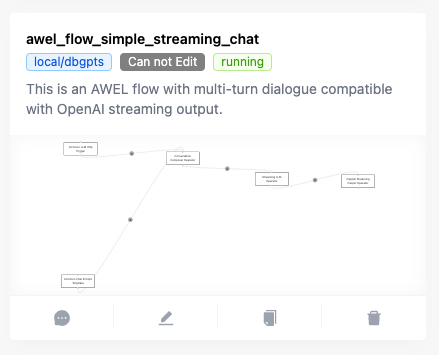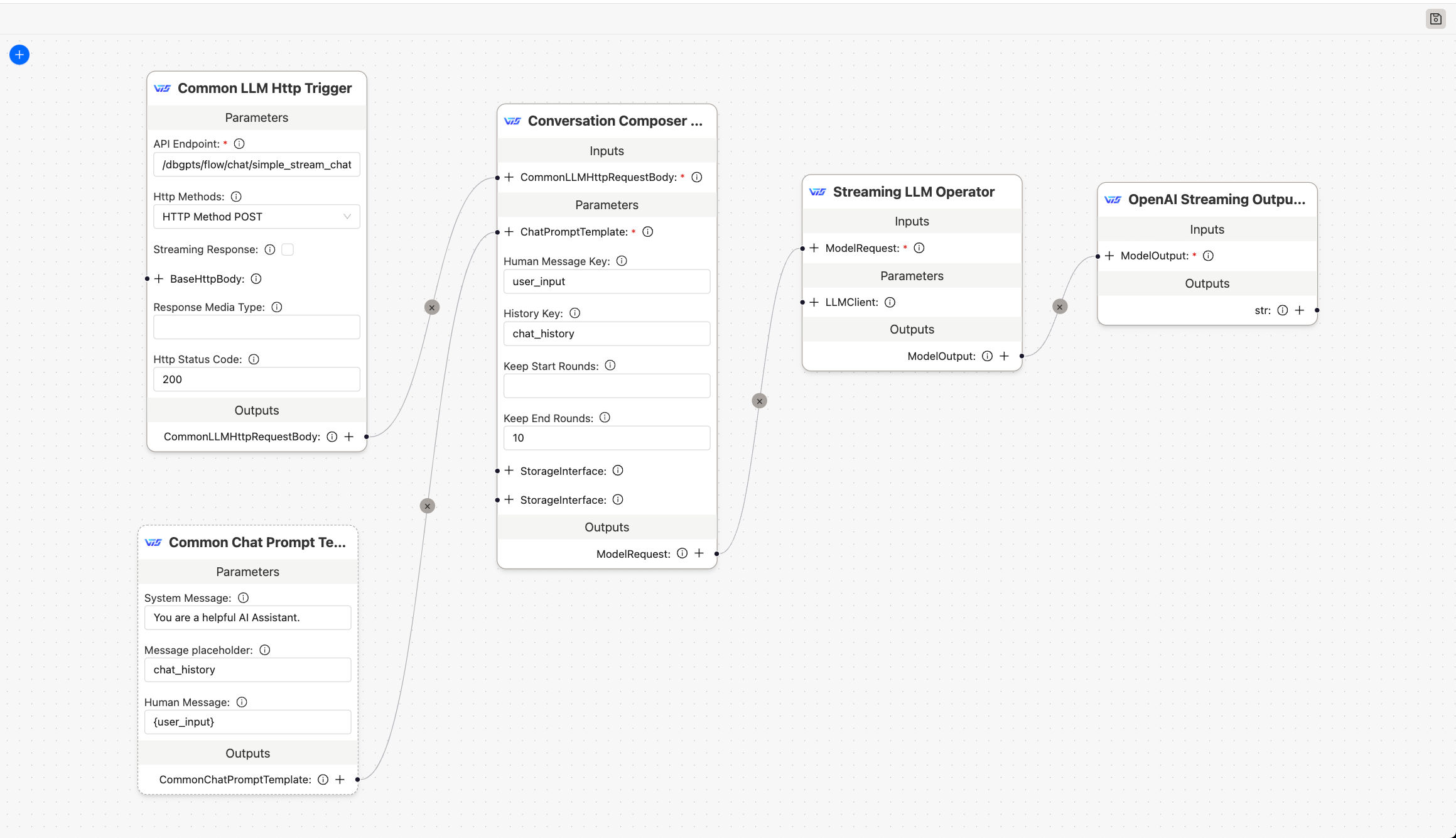dbgpts
dbgpts contains some data apps, AWEL operators, AWEL workflows, agents and resources which build upon the DB-GPT.
Introduction
Why We Need dbgpts
In a production-level LLM's application, there are many components that need to be integrated, and you want to start your research and creativity quickly by using the existing components.
At the same time, we hope that the core components of DB-GPT keep simple and easy to maintain, and some complex components can be developed in the form of plugins.
So, we need a plugin system to extend the capabilities of DB-GPT, and dbgpts is the
plugin system or a part of ecosystem of DB-GPT.
What Is dbgpts
There are some concepts in dbgpts:
app: It includes data apps, AWEL operators, AWEL workflows, agents and resources, sometimes, we call itdbgptsapp ordbgptspackage.repo: It is a repository ofdbgptsapps, you can install adbgptsapp from adbgptsrepo, the defaultdbgptsrepo is eosphoros-ai/dbgpts, you can also create your owndbgptsrepo or use other'sdbgptsrepo.
How To Run dbgpts
- When you install a
dbgptsapp, it will be loaded to your DB-GPT webserver automatically, and you can use it in the DB-GPT webserver or trigger it by command linedbgpt run .... - You can also run a
dbgptsapp as a command line tool, you can use it in your terminal bydbgpt app run ...with--localoption, it will run the app in your local environment.
Quick Start
Let's install a dbgpts package named awel-flow-simple-streaming-chat
dbgpt app install awel-flow-simple-streaming-chat -U
Run The App Locally
Then, you can run the app in your terminal:
dbgpt run flow --local chat \
--name awel-flow-simple-streaming-chat \
--model "gpt-3.5-turbo" \
--messages "hello" \
--stream
dbgpt run flow: Means you want to run a AWEL workflow.--local: Means you want to run the workflow in your local environment without starting the DB-GPT webserver, it will find theappinstalled in your local environment, then run it, also, you can use--fileto specify the python file.--name: The name of the app.--model: The LLM model you want to use,awel-flow-simple-streaming-chatwill use OpenAI LLM by default if you run it with--local.--messages: The messages you want to send to the LLM.--stream: Means you want to run the workflow in streaming mode.
The output will be like this:
You: hello
[~info] Chat stream started
[~info] JSON data: {"model": "gpt-3.5-turbo", "messages": "hello", "stream": true}
Bot:
Hello! How can I assist you today?
🎉 Chat stream finished, timecost: 1.12 s
Run The App In DB-GPT Webserver
After you install the awel-flow-simple-streaming-chat app, you can run it in the DB-GPT webserver.
Also, you can use the dbgpt command line tool to trigger the app.
dbgpt run flow chat \
--name awel-flow-simple-streaming-chat \
--model "chatgpt_proxyllm" \
--messages "hello" \
--stream
You just remove the --local option, then the command will connect to the DB-GPT webserver and run the app.
And you should modify the --model option to your model name in the DB-GPT webserver.
The output will be like this:
You: hello
[~info] Chat stream started
[~info] JSON data: {"model": "chatgpt_proxyllm", "messages": "hello", "stream": true, "chat_param": "1ecd35d4-a60a-420b-8943-8fc44f7f054a", "chat_mode": "chat_flow"}
Bot:
Hello! How can I assist you today?
🎉 Chat stream finished, timecost: 0.98 s
Run The App With command Mode
In previous examples, we run the app in chat mode, but not all dbgpts apps support chat mode,
some apps support command mode, you can run the app with dbgpt run flow cmd command.
Run The App Locally
dbgpt run flow --local cmd \
--name awel-flow-simple-streaming-chat \
-d '
{
"model": "gpt-3.5-turbo",
"messages": "hello",
"stream": true
}
'
We replace the chat mode with cmd mode, and use -d option to specify the data in JSON format.
The output will be like this:
[~info] Flow started
[~info] JSON data: {"model": "gpt-3.5-turbo", "messages": "hello", "stream": true}
Command output:
Hello! How can I assist you today?
🎉 Flow finished, timecost: 1.35 s
Run The App In DB-GPT Webserver
Just remove the --local option, then the command will connect to the DB-GPT webserver and run the app.
dbgpt run flow cmd \
--name awel-flow-simple-streaming-chat \
-d '
{
"model": "chatgpt_proxyllm",
"messages": "hello",
"stream": true
}
'
The output will be like this:
[~info] Flow started
[~info] JSON data: {"model": "chatgpt_proxyllm", "messages": "hello", "stream": true}
Command output:
Hello! How can I assist you today?
🎉 Flow finished, timecost: 1.09 s
chat Mode vs command Mode
In short, chat mode is used for chat applications, and command mode is used to
trigger the app with a command.
For example, you want to load your documents to the DB-GPT, you can use command mode
to trigger the app to load the documents, it always runs once and the result will be
returned.
And chat mode is a special case of command mode, it provides a chat interface to
the user, and you can chat with the LLM in an interactive way.
Run You App With Python Script
If you run app locally, it will find the app which is installed in your local environment, also, you can run the app by providing the python file.
Let's create a python file named simple_chat_app.py:
import os
from dbgpt._private.pydantic import BaseModel, Field
from dbgpt.core import ModelMessage, ModelRequest
from dbgpt.core.awel import DAG, HttpTrigger, MapOperator
from dbgpt.model.proxy import OpenAILLMClient
from dbgpt.model.operators import LLMOperator
class TriggerReqBody(BaseModel):
model: str = Field(..., description="Model name")
messages: str = Field(..., description="User input")
class RequestHandleOperator(MapOperator[TriggerReqBody, ModelRequest]):
def __init__(self, **kwargs):
super().__init__(**kwargs)
async def map(self, input_value: TriggerReqBody) -> ModelRequest:
messages = [ModelMessage.build_human_message(input_value.messages)]
return ModelRequest.build_request(input_value.model, messages)
with DAG("dbgpts_simple_chat_app") as dag:
# Receive http request and trigger dag to run.
trigger = HttpTrigger(
"/dbgpts/simple_chat_app", methods="POST", request_body=TriggerReqBody
)
llm_client = OpenAILLMClient(
model_alias="gpt-3.5-turbo", # or other models, eg. "gpt-4o"
api_base=os.getenv("OPENAI_API_BASE"),
api_key=os.getenv("OPENAI_API_KEY"),
)
request_handle_task = RequestHandleOperator()
llm_task = LLMOperator(llm_client=llm_client)
model_parse_task = MapOperator(lambda out: out.text)
trigger >> request_handle_task >> llm_task >> model_parse_task
Then you can run the app by providing the python file:
dbgpt run flow --local --file simple_chat_app.py \
chat \
--name dbgpts_simple_chat_app \
--model "gpt-3.5-turbo" \
--messages "hello"
The output will be like this:
You: hello
[~info] Chat started
[~info] JSON data: {"model": "gpt-3.5-turbo", "messages": "hello", "stream": false}
Bot:
Hello! How can I assist you today?
🎉 Chat stream finished, timecost: 1.06 s
And you can run previous examples with command mode.
dbgpt run flow --local --file simple_chat_app.py \
cmd \
--name dbgpts_simple_chat_app \
-d '
{
"model": "gpt-3.5-turbo",
"messages": "hello"
}'
The output will be like this:
[~info] Flow started
[~info] JSON data: {"model": "gpt-3.5-turbo", "messages": "hello"}
Command output:
Hello! How can I assist you today?
🎉 Flow finished, timecost: 1.04 s
Show Your App In DB-GPT Webserver
When you install the workflow, you can see the workflow in the DB-GPT webserver, you can open
the AWEL Flow page, then you can see the workflow named awel_flow_simple_streaming_chat.

Then you can click the edit button to see the details of the workflow.

Note: Not all workflows support editing, there are two types of workflows according to the
definition type: json and python, the json type workflow can be edited in the DB-GPT,
We will show you more details in the next sections.